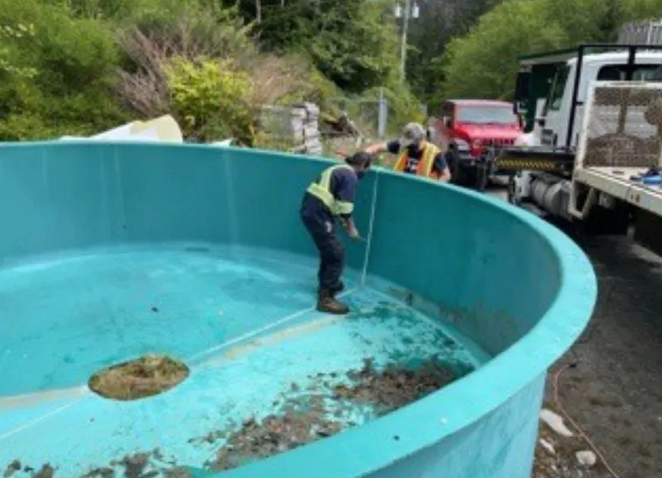Zeballos Hatchery gets upgrade.
Ehattesaht/Chinexint First Nation, Canada’s Department of Fisheries & Oceans, and Grieg Seafood have joined forces to support chum salmon in Zeballos, British Columbia.
Representatives from the Ehattesaht, the Nuu-chah-nuth Tribal Council (NTC), DFO and Grieg began discussing upgrades and options for the Zeballos Hatchery a year and a half ago.
They decided the priority was to remove the existing steel tank, which was posing a risk, and, once it was determined a tank from Grieg would fit the requirements of the hatchery, a date was set to replace the old steel tank.

The project also received funding from the Department of Fisheries & Oceans (DFO), Grieg wrote in a press release.
“The old tank was rotten and ready to tip over, so plans to move the tank were of the utmost importance to the safety of everyone in and around the hatchery,” said Dave Miller, the Ehattesaht Chinexint Fisheries’ advisor.
“With the help from Totem Bar Contracting, a local road builder and road contractor, I made contact with Glen McCall to have him come and remove the old tank. When asked, Glen said ‘No problem and no charge.’ He donated his excavator and his time with a crew to help remove the tank.”
Miller then ravelled to Grieg Seafood’s freshwater hatchery in Gold River to pick up the round tank, which had been dismantled for transportation. Pieces were loaded onto a flat-bed truck and transported back to Zeballos, where it was put together by Miller and NTC’s Jamie James.
“We hope to capture brood stock this year in the amount of 20,000 chum eggs, and work towards a Chinook brood take from the Zeballos River in a few years, as we have done in the past,” Miller said.

“With the new tank replacement, as well as the upgrades to the hatchery, operations will run a lot smoother for us. This is our hope. I’d like to thank Grieg for the donation of the circular tank and also all those who contributed to the work. There’s still lots to complete,” he added.
“It’s important to work with First Nations communities in any capacity, whether by donating equipment, or by providing the skill and expertise within Grieg,” said OD Hansen, Grieg’s Director of Reconciliation & Partnerships.
“Grieg will continue to work and support our partners on projects that will enhance wild salmon restoration,” he added.

